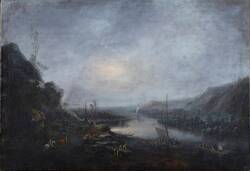The main protagonist in Caspar David Friedrich’s Seashore in Moonlight is rather unusual – it is the air itself. And in particular, the spectacular view of a thunderstorm’s dense clouds, hanging low over the sea, drifting towards the horizon. Almost nothing distracts us from them – apart from its three ships, the composition is conspicuously empty.
Friedrich often painted meteorological phenomena such as clouds or fog. Sometimes they dominate his painting so completely that, as one contemporary remarked, such subjects should no longer be described as “landscapes”, but more properly called “airscapes”. To capture different atmospheric states as convincingly as possible, Friedrich had to concentrate intently, something his wife Caroline certainly noticed: “On the day he is painting air, he may not be spoken to!”
Before Friedrich, very few painters had explored the atmospheric treatment of landscapes as intensively. One exception was Johann Alexander Thiele, who painted the large work further to the right. Nearly one hundred years before Friedrich, he tried to capture the nature of fog, clouds and rain in his painting. In Thiele’s view of The Elbe at Sörnewitz, you can see how he alternated clear and hazy sections of the landscape, deliberately painting some of the latter parts slightly out of focus. In those days, Thiele was a leading landscape painter, and Friedrich certainly would have known his works.
Further Media
- Location & Dating
- 1835/36
- Material & Technique
- Oil on canvas
- Museum
- Hamburger Kunsthalle
- Inventory number
- Hamburger Kunsthalle, Inv.-Nr. HK-5489
